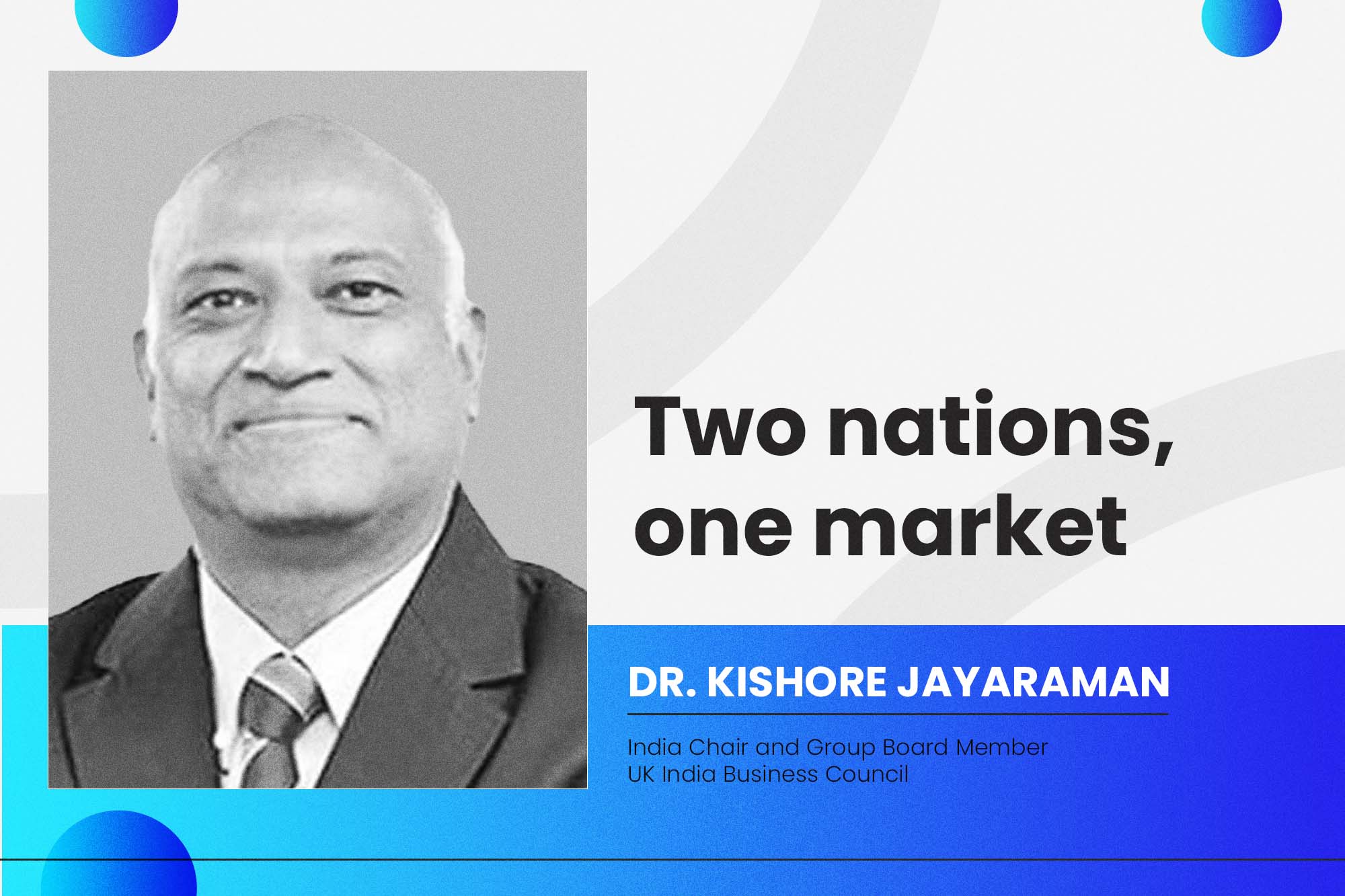Two nations, one market
By Staff Report June 5, 2025 8:08 pm IST
The world is fast becoming one integrated market, driven by efforts from leading economies to simplify trade and improve global accessibility. In this context, Dr. Kishore Jayaraman from the UK India Business Council highlights how the UK and India work together to shape a more connected and collaborative global economy.
With evolving global supply chain strategies, how can India position itself as a co-innovation partner rather than just a low-cost hub for UK and EU manufacturers?
India’s growth is unprecedented; it is no longer just the back office or low-cost hub of the world—it’s rapidly evolving into a front-runner in product development, digital transformation, and sustainability-focused solutions. With 100+ unicorns and thousands of tech startups, India offers agility and innovation. At UKIBC, we work towards helping British firms understand the Indian opportunity. There is tremendous scope for India to partner with UK firms; the two countries can co-develop next-gen solutions in EVs, health tech, or green hydrogen while leveraging cost efficiency and creative capacity. India’s digital infrastructure, digital payments system, and growing expertise in AI, IoT, Industry 4.0, and clean energy put India in a unique place to go beyond cost arbitrage and become a co-creator of high-value, sustainable solutions. The time is ripe to shift from outsourcing to co-innovation.
What are UK manufacturers’ and investors’ key concerns or expectations when considering India as a strategic production or R&D base?
British companies are committed to manufacturing in India. They would welcome policies that help them integrate India into their supply chains without impacting their efficiency. For example, a facilitative tariff and standards regime that allows investors to invest and build an India supply chain in a phased manner over the medium—to long-term would help unlock significant inflows of further investment.
Equally, UK investors are keen to bring and create new IPs in India and jointly develop with Indian partners. Policies that provide adequate protection and commercial compensation for their IP can catalyse this.
Businesses would also welcome certain business environment optimisations, such as shorter timelines for approvals and a more consistent and transparent approach across Government Departments, States, and regulators for approvals and clearances.
Businesses feel that taxation policies and the overall regulatory treatment should centre on providing a level playing field to all investors.
How do you view the impact of India’s PLI schemes, FTA discussions, and Make in India 2.0 on actual foreign investment flows?
This is an exciting chapter of India-UK relations, with alignment on 26 chapters, that the 5th and 6th largest economies agreed to an FTA of this magnitude. The benefits to both India and the UK are palpable and very high. The trade deal will encourage co-manufacturing between India and the UK in key strategic areas, some of which were highlighted in the Technology Security Initiative signed by both governments in July 2024. Most importantly, this FTA could give small and medium-sized enterprises (MSMEs)—even those not based in the UK or India—better access to join and contribute to global supply chains.
India is moving towards Aatma Nirbhar Bharat, which promotes self-reliance, especially in defence. India is focused on indigenisation, building reliable defence technology supply chains, securing access to critical technology, increasing exports, and creating domestic manufacturing jobs. The UK’s sophisticated defence industry can support this mission. PLI, FTAs, and Make in India 2.0 are not isolated moves—they’re part of a coordinated policy architecture to position India as a trusted, tech-forward manufacturing and innovation partner. While execution and follow-through remain key, the direction is positive and already influencing investor decisions.
What sectors show the most promise for UK-India collaboration in high-tech manufacturing and digital industrial innovation?
A trade or strategic deal between the UK and India would benefit various sectors, fostering growth in both economies. In the technology and digital services sector, the UK can access India’s skilled tech workforce and its expanding digital market. At the same time, India benefits from increased collaboration with UK tech firms, particularly in areas such as AI, cybersecurity, and fintech. In pharmaceuticals and healthcare, the UK would gain by importing cost-effective generic drugs and medical devices from India. At the same time, India would benefit from research partnerships, clinical trials, and easier drug approvals in the UK.
Green energy and sustainability are other key sectors, with the UK having opportunities to export green technologies and offer consulting services for carbon management. India stands to gain significant investment in renewable energy infrastructure and achieve its net-zero goals through partnerships with the UK. The UK would benefit from diversified and cost-effective manufacturing partnerships in India in manufacturing and supply chains. At the same time, India could secure more foreign direct investment (FDI) in advanced manufacturing and smart factory initiatives.
Finally, the UK could secure defence contracts and tech collaborations in the defence and aerospace sectors. At the same time, India would benefit from co-development opportunities and the modernisation of its defence systems. These sectors collectively represent areas where both nations would find substantial growth and opportunity in a strategic deal.
Are Indian OEMs and startups getting closer to global aerospace, mobility, or precision engineering standards – or is the gap still significant?
India’s OEMs and deep-tech startups are making impressive strides toward global standards—particularly in aerospace components, electric mobility, and precision engineering.
In aerospace, companies are now part of global supply chains, delivering components to stalwarts. In e-mobility, startups are designing products at par with global counterparts regarding software integration and design-for-manufacture. The gap with global standards is closing—especially in top-tier OEMs and forward-looking startups. India’s challenge is replicating that quality and innovation culture across the broader industrial base, enabling scalable excellence.
From a UKIBC perspective, what policy or structural reforms are most urgently needed in India to attract the next wave of global manufacturers?
As mentioned earlier, British firms are looking forward to the Indian opportunities. There has been tremendous policy impetus by the Indian government to ensure a level playing field. However, in our member consultations, we gauge that ease of doing business optimisations such as shorter timelines for approvals and a more consistent, transparent approach across Government Departments, States, and regulators for clearances are also important. Overall, continued efforts to provide a level playing field, allowing all businesses in India, including international companies, to operate and access the same opportunities, would signal a strong progressive investment climate.
What message would you give Indian MSMEs aspiring to become global suppliers or Tier 1 partners to multinationals?
The world is looking for resilient, cost-effective, innovation-driven supply partners—and Indian MSMEs are in a prime position. But success will go to those who aim high, invest in quality, and commit to the long game.
Cookie Consent
We use cookies to personalize your experience. By continuing to visit this website you agree to our Terms & Conditions, Privacy Policy and Cookie Policy.
















